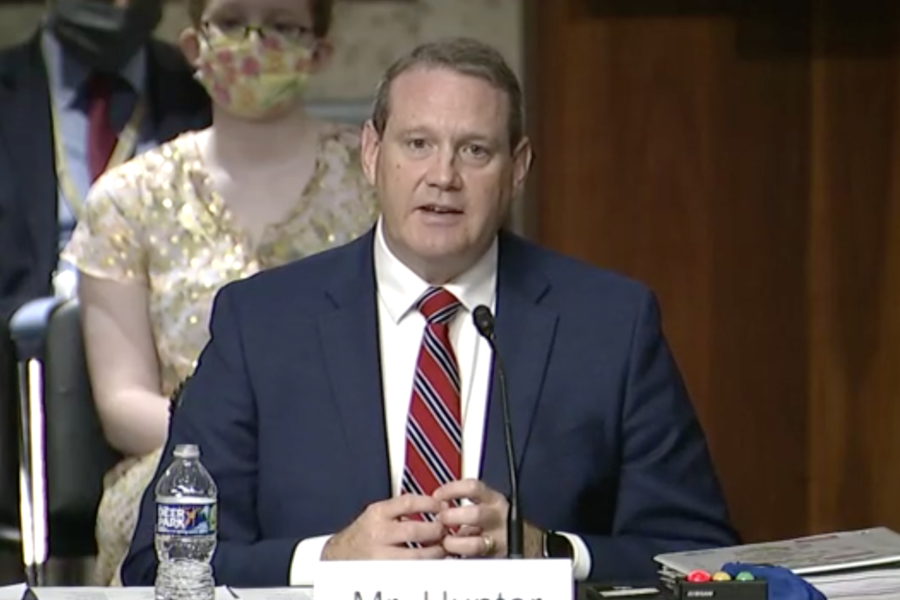FARNBOROUGH, U.K.—Air Force acquisition chief Andrew Hunter sees the need for faster design and development cycles for the service—they just likely won’t happen as quickly as his predecessor pushed for.
As part of a panel discussion at the Farnborough International Airshow, Hunter laid out his view of an Air Force acquisition and sustainment enterprise very much starting to take advantage of cutting-edge capabilities such as digital design and 3-D printing after years of futuristic promise.
But he stopped short of calling for new innovations to be delivered at breakneck pace. Will Roper, on the other hand—who preceded Hunter as assistant secretary for acquisition, technology, and logistics—made waves by calling for the Air Force to build new fighter models every five years, leveraging digital engineering, agile software development, and modular, open architectures.
Subsequent Air Force leaders, however, have backed off those aggressive timelines. Secretary Frank Kendall, in particular, made it clear that it will take longer to develop platforms such as the fighter at the heart of the Next Generation Air Dominance program.
Hunter, for his part, called Roper’s goals “challenging,” but also indicated his support for moving faster and with more urgency.
“Our hope is that we will be able to have a faster pace in delivering new systems, new products. My predecessor in this job talked quite a bit about the goal to get there, and he had some very challenging parameters about how rapidly we were going to produce new fighter aircraft and aircraft. … But I do think we can definitely see a faster pace of adoption,” said Hunter. “And we see the need for it. So from an Air Force perspective, there is a need for new systems that is pretty sharp and pretty urgent. Particularly when it comes to uncrewed aircraft, there’s a lot of work to be done in that space.”
Like Roper, Hunter also strongly endorsed the potential of digital engineering, whereby digital models of new platforms are designed, constructed and tested. In particular, Hunter pointed to common design tools as especially useful because they allow for industry and government to integrate and collaborate more easily.
“When it comes to projects where we’re really early on and we’re engaging with multiple industry partners and multiple design houses and their teams that support them underneath … being in the same design tool [means] the government can evaluate what’s happening and what the quality of the design is and its predicted performance with its own people in the same tool,” Hunter said. “Not with a stack of paper that has to be FedExed to Wright-Patterson Air Force Base and delivered by 5 p.m. on a Saturday. It’s just instantaneous because we’re working together on it. And what that drives, it drives a more agile development and design process.”
Such an approach isn’t notional, Hunter said—it’s currently being used as part of the NGAD program
“And it’s not just with a contractor that’s already been selected,” Hunter added. “It’s with multiple competitors. So I think it’s helping us drive a more competitive process, even in areas of government procurement where traditionally competition is hard to get.”
Digital engineering could also improve sustainability, he added, as designs can be tweaked, modeled, and simulated thousands of times to maximize efficiency before they’re actually built.
But it’s not just digital engineering that Hunter sees as a technique of the future being deployed now. He also pointed to the Air Force’s use of additive manufacturing as a modern industry innovation that has made its way into the service.
“Even on old aircraft … we can resurface parts. So as parts get worn, we use a cold spray technique to lay down new layers of metal on an existing part and essentially bring it back to a like new condition, and put it back on the jet,” Hunter said. “The performance is restored … to almost like new condition and have it go on for years. And there are cases where a lot of those parts are challenging, if not impossible, to buy spares. They’re no longer in production. So it’s a really critical capability.”
All told, innovations like those are pushing Air Force depots to look more like “factories of the future,” Hunter said. And while there’s still some older “specific tooling” that is used for certain aircraft, the overall approach is shifting to one based on modern industrial innovations.

